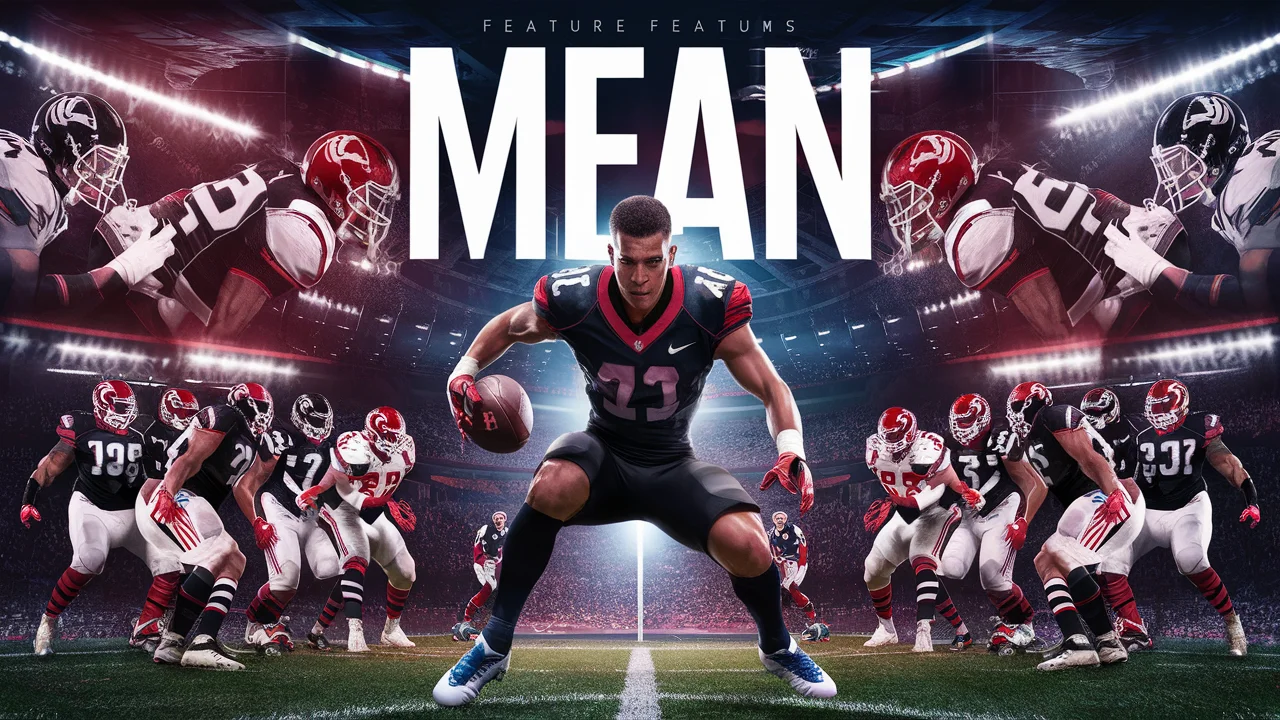In the world of football, understanding specific terminology is crucial for fans and players alike. One term that often sparks curiosity is “ATH,” which stands for “athlete” and represents a versatile player role in the sport. Here’s why getting a grip on what ATH means is essential:
- Definition: ATH refers to a player with the ability to perform various roles on the field, offering flexibility in team strategies.
- Relevance: This term impacts how teams utilize players and how fans and analysts interpret player statistics.
- Context: Knowing what ATH means helps in understanding player positions, drafting strategies in fantasy football, and analyzing game strategies.
By delving into the term ATH, you’ll gain insights into its historical background, its role in player positions, and its significance in both real-life games and fantasy football leagues. This understanding will enhance your overall football knowledge and appreciation of player versatility.
1. Definition of ATH
The term “ATH” in football stands for “athlete,” but its usage and implications go beyond just being a general term for athleticism. Here’s a breakdown of what ATH represents and how it’s applied:
- Basic Definition: In football, ATH is shorthand for a player who is highly versatile and capable of performing multiple roles on the field. Unlike traditional positions like quarterback (QB) or wide receiver (WR), an ATH player’s primary characteristic is their flexibility.
- General Usage: ATH is often used in team rosters and recruiting to denote players who can fit into various positions based on team needs. This flexibility allows coaches to utilize ATH players in different scenarios, making them valuable assets to the team. For instance, an ATH might be used as a running back, wide receiver, or even a defensive back depending on the game situation.
- Examples in Context: Consider a player like Tyreek Hill, who has been utilized in multiple offensive roles for the Kansas City Chiefs. His ability to switch between wide receiver and running back positions exemplifies the ATH concept. Similarly, defensive players with ATH designation may switch between safety and cornerback roles to exploit matchups against opposing teams.
In summary, ATH is a term that highlights a player’s ability to excel in various positions, providing teams with strategic advantages and flexibility in their game plans. Understanding this term enhances your grasp of football strategy and player utilization.
2. Historical Context and Evolution
The term “ATH” in football has evolved significantly since its inception, reflecting changes in the sport and how players are utilized. Here’s a look at the historical development and shifts in the use of ATH:
- Origins of the Term: The ATH designation originally emerged as a way to classify players who exhibited exceptional athleticism but didn’t fit neatly into traditional football positions. In the early days of football, players were often limited to specific roles based on their physical attributes and skills. As the game evolved, the need for versatile players became more apparent, leading to the adoption of the ATH label.
- Changes Over Time: Initially, ATH was primarily used in recruiting and high school football to describe standout athletes who could play multiple roles. However, with the increasing emphasis on versatility in professional football, the term has gained prominence in the NFL and other leagues. Coaches and analysts now use ATH to highlight players who can adapt to various positions, reflecting a broader trend towards flexibility and multi-role capabilities in football.
- Influence of Modern Football: In today’s game, the ATH designation is more than just a label; it signifies a player’s strategic value. Teams actively seek ATH players during drafts and trades for their ability to fill different positions as needed. This trend is driven by the modern football landscape, where adaptability and the ability to perform under varying conditions are highly valued.
In essence, the evolution of the ATH term mirrors the broader shifts in football towards valuing versatility and adaptability. Understanding this historical context helps appreciate how ATH players have become integral to team strategies and game dynamics.
3. The Role of ATH in Player Positions
The ATH designation plays a crucial role in defining player positions and strategies on the football field. Here’s a detailed look at how ATH impacts various player roles:
- Positions: ATH players are known for their ability to excel in multiple positions, making them valuable assets to any team. They are not restricted to one specific role but can be deployed in various positions depending on the team’s needs and game situation. For example:
- Offensive Roles: An ATH might be used as a running back, wide receiver, or even a quarterback, depending on their skill set and the team’s strategy.
- Defensive Roles: On defense, ATH players can switch between positions such as safety, cornerback, or linebacker, providing flexibility to counter different offensive schemes.
- Examples:
- Pat Mahomes: Known for his versatility and ability to play multiple offensive roles effectively, he exemplifies the ATH concept. His skills allow him to adapt and contribute in various ways, enhancing the team’s offensive strategy.
- Jamal Adams: As a defensive player, Adams showcases ATH qualities by excelling in both safety and linebacker roles, adjusting his position based on game demands and opponent strategies.
- Strategic Benefits: The ATH role provides several strategic advantages for teams:
- Flexibility: ATH players can be moved around to exploit mismatches against opponents, offering coaches the ability to adjust their game plan dynamically.
- Injury Replacement: Having versatile ATH players allows teams to effectively manage injuries, as these players can step into different positions as needed.
- Game Situations: ATH players can be used in specific game situations, such as crucial third-down plays or special teams, where their versatility adds an extra layer of strategy.
In summary, the ATH designation enhances a team’s ability to adapt and strategize by utilizing players in various positions. Understanding the role of ATH in player positions highlights the importance of versatility in modern football and how it contributes to overall team success.
4. ATH in Football Statistics and Analytics
The term “ATH” not only impacts player roles but also plays a significant role in football statistics and analytics. Here’s how ATH influences various aspects of football data and performance analysis:
- Statistical Relevance: ATH players contribute to a range of statistics due to their versatility. Unlike players confined to specific positions, ATHs can impact various statistical categories. For example:
- Offensive Stats: ATH players might contribute to rushing yards, receiving yards, and touchdowns. Their ability to switch between positions means they can accumulate stats across different categories.
- Defensive Stats: On the defensive side, ATH players can contribute to tackles, interceptions, and sacks, depending on their role in the game.
- Data Metrics: Specific metrics are associated with ATH players to gauge their effectiveness and versatility. Key metrics include:
- Versatility Score: A measure of how effectively a player performs in multiple positions.
- Impact Index: Evaluates the overall impact of an ATH player on game outcomes based on their contributions in different roles.
- Efficiency Ratings: Assesses how efficiently ATH players perform their roles compared to other specialists in those positions.
- Example Analysis: To illustrate the impact of ATH players on statistics, consider a player like Deebo Samuel. His performance metrics show contributions as both a wide receiver and a running back, reflecting his ATH designation. Samuel’s stats, such as combined rushing and receiving yards, provide insights into his versatility and overall value to the team.
- Advanced Analytics: Modern football analytics use advanced metrics to assess the performance of ATH players. These include:
- Player Tracking Data: Tracks ATH players’ movements on the field to analyze their effectiveness in different positions.
- Game Situation Analysis: Evaluates ATH players’ performance in various game situations, such as high-pressure moments or crucial plays.
In essence, ATH players influence a broad spectrum of football statistics and analytics. Their versatility allows them to contribute in multiple areas, making them valuable for both traditional and advanced performance assessments. Understanding these aspects helps in appreciating the full impact of ATH players on game strategies and outcomes.
5. Comparing ATH to Other Terms
The ATH designation is often compared to other football terms and positions, each with its unique characteristics and strategic implications. Here’s a detailed comparison to highlight the distinctions and overlaps:
- ATH vs. WR (Wide Receiver):
- Role: A wide receiver (WR) specializes in catching passes from the quarterback and gaining yards through receptions. In contrast, an ATH is a versatile player who can take on multiple roles, including but not limited to wide receiver.
- Flexibility: ATHs can play various offensive and defensive roles, whereas WRs are primarily focused on receiving and sometimes blocking. This flexibility allows ATHs to adapt to different game situations and strategies.
- Usage: While WRs are crucial for passing plays, ATHs are valuable for their ability to fill in gaps in multiple positions, providing teams with strategic options beyond just receiving.
- ATH vs. RB (Running Back):
- Role: Running backs (RBs) are primarily responsible for carrying the ball on rushing plays. ATH players, however, can also play as RBs but are not limited to this position alone.
- Versatility: ATH players can switch between running back and other roles like wide receiver or defensive back, offering more strategic flexibility than a typical RB.
- Impact: ATHs contribute to multiple aspects of the game, while RBs focus primarily on rushing yards and short-yardage situations.
- ATH vs. QB (Quarterback):
- Role: Quarterbacks (QBs) are responsible for directing the offense, throwing passes, and managing the game’s tempo. ATH players, in contrast, are not confined to one role and can play various positions, including quarterback.
- Specialization: QBs have a specialized role with specific skills, such as passing accuracy and decision-making. ATH players have a broader skill set that allows them to perform in multiple roles, offering flexibility in game plans.
- Strategic Use: While QBs are central to offensive strategies, ATHs provide additional options and can be utilized in different ways based on the team’s needs.
- ATH vs. DB (Defensive Back):
- Role: Defensive backs (DBs) focus on defending against passing plays and covering receivers. ATH players can also play as DBs but have the added ability to contribute in various other roles.
- Versatility: ATHs can switch between defensive back positions and other roles, such as wide receiver or running back, providing a strategic advantage in various game situations.
- Usage: While DBs are specialized in pass defense, ATH players offer a broader range of skills that can be applied across different positions, enhancing defensive strategies.
In summary, the ATH designation stands out for its flexibility and adaptability compared to other specific football terms and positions. Understanding these differences helps in appreciating the unique value that ATH players bring to a team, offering strategic options and versatility that extend beyond traditional roles.
6. The Impact of ATH on Team Strategies
The ATH designation has a profound impact on team strategies, offering unique advantages that can shape game plans and overall team performance. Here’s how ATH players influence various aspects of team strategy:
- Strategic Use: ATH players provide coaches with a range of strategic options due to their ability to perform in multiple roles. This flexibility allows teams to adjust their strategies based on the opponent’s weaknesses or changing game situations. For example:
- Offensive Strategy: An ATH player can be utilized in different offensive positions, such as wide receiver or running back, to exploit mismatches against the defense. This adaptability can create opportunities for big plays and diversify the offense.
- Defensive Strategy: On defense, ATH players can switch between positions like safety or cornerback, making it harder for the opposing team to predict defensive schemes and coverage.
- Case Studies:
- The New England Patriots: The Patriots, under Bill Belichick, have famously utilized ATH players to their advantage. Players like Julian Edelman have been used in various roles, from wide receiver to occasional running back, to maximize their impact on the game.
- The San Francisco 49ers: The 49ers have employed versatile ATH players such as Deebo Samuel, who has played as both a wide receiver and running back, demonstrating how ATHs can be integral to a dynamic offensive scheme.
- Game Situations: ATH players are especially valuable in specific game situations where versatility can make a difference:
- Injury Management: When key players are injured, ATH players can step in and fill multiple roles, minimizing the impact on team performance.
- Special Teams: ATH players can also contribute to special teams, providing an additional layer of strategy for kick returns, punt coverage, and other special teams plays.
- Flexibility in Game Plans: The ability to use ATH players in various roles allows coaches to craft flexible game plans that can adapt to different opponents and situations. This flexibility is crucial in a fast-paced sport where in-game adjustments can be the key to victory.
In essence, the ATH designation enhances a team’s strategic capabilities by providing flexibility and adaptability. The impact of ATH players on team strategies is significant, allowing for creative and dynamic approaches to both offense and defense, ultimately contributing to overall team success.
7. The Role of ATH in Fantasy Football
In fantasy football, the ATH designation can significantly influence team management and player selection. Here’s how ATH players impact fantasy football and tips for effectively incorporating them into your fantasy team:
- Fantasy Implications: ATH players bring versatility to fantasy football leagues, allowing managers to use them in multiple positions. This flexibility can be advantageous when dealing with injuries or bye weeks. For example:
- Scoring Potential: ATH players who can perform in both running back and wide receiver roles provide multiple avenues for scoring points, potentially increasing their value.
- Roster Flexibility: Having an ATH on your roster can allow you to adapt to changing circumstances throughout the season, such as injuries to other players or shifts in performance.
- Drafting Strategies: When drafting for your fantasy football team, consider the following strategies for ATH players:
- Value Picks: Look for ATH players who are undervalued or overlooked in drafts. Their ability to contribute in multiple positions can provide significant value.
- Injury Insurance: ATH players can serve as valuable insurance for key positions. If your primary running back or wide receiver is injured, an ATH player can fill in effectively.
- Matchup Considerations: Pay attention to matchups and game situations where ATH players might be used in more impactful roles. For instance, if a player is expected to see increased usage due to an opponent’s weak defense in a specific area, they might be a good pick for that week.
- Examples of ATH Impact: Consider players like Tyreek Hill or Deebo Samuel, who have demonstrated their versatility and impact in fantasy leagues. Their ability to contribute in multiple roles, such as running back and wide receiver, makes them valuable assets for fantasy teams.
- Adjusting to Performance Trends: Monitor ATH players’ performance trends throughout the season. Their role may fluctuate based on team needs or game plans, so staying updated on their usage can help you make informed decisions about when to start or bench them.
- Trade Considerations: ATH players can be valuable trade assets due to their versatility. If you need to address specific needs on your team, consider trading for or away ATH players based on their current performance and your team’s requirements.
In summary, ATH players offer significant advantages in fantasy football through their versatility and potential to contribute in various positions. By understanding their impact and employing strategic drafting and management techniques, you can enhance your fantasy team’s performance and adaptability throughout the season.
8. Common Misconceptions about ATH
Despite its utility, the ATH designation often comes with misconceptions that can cloud understanding and usage in football. Here’s a closer look at some common myths and clarifications about ATH players:
- Misconception 1: ATH Players Are Jack-of-All-Trades, Master of None
- Clarification: While it’s true that ATH players are versatile, it doesn’t mean they lack specialization. Many ATHs are highly skilled in multiple areas, allowing them to excel in various roles. For example, a player like Deebo Samuel is proficient as both a wide receiver and a running back, showing that ATHs can indeed master multiple positions.
- Misconception 2: ATH Players Are Less Valuable Than Specialized Players
- Clarification: ATH players offer unique value through their adaptability. Their ability to fill various roles can be more beneficial than specializing in just one position, especially in situations involving injuries or strategic adjustments. This versatility can make ATHs indispensable in both team dynamics and fantasy football.
- Misconception 3: ATH Designation Is Only for College or High School Football
- Clarification: While the ATH label is common in high school and college football, it’s also relevant in professional leagues like the NFL. Teams value ATH players for their ability to contribute in multiple roles, making them valuable assets at all levels of the sport.
- Misconception 4: ATH Players Are Ineffective in Specific Roles
- Clarification: ATH players are often highly effective in the roles they play, even though they may not specialize in just one area. For instance, an ATH who plays as a wide receiver and running back can still deliver strong performances in each role due to their diverse skill set and adaptability.
- Misconception 5: ATH Players Are Only Useful for Teams with Flexible Game Plans
- Clarification: While ATHs are indeed beneficial for teams with dynamic strategies, their versatility can also be advantageous for teams with more traditional game plans. ATH players can provide valuable depth and options, helping teams adjust to various in-game scenarios and opponent strategies.
- Expert Opinions: Coaches and analysts often highlight the importance of ATH players for their versatility and ability to adapt. According to NFL coaches, having players who can perform multiple roles enhances strategic flexibility and depth, proving that ATHs are integral to modern football strategies.
In summary, understanding and addressing these misconceptions about ATH players helps in appreciating their true value and impact. ATH players are not just versatile but also skilled and valuable assets in both team strategies and fantasy football.
9. Real-Life Examples of ATH Players
Real-life examples of ATH players highlight their versatility and impact on football teams. Here are some notable ATH players who exemplify the role and demonstrate how their versatility contributes to their teams:
- Deebo Samuel (San Francisco 49ers):
- Roles: Samuel has played as both a wide receiver and a running back, showcasing his versatility in the 49ers’ offense.
- Impact: His ability to contribute in multiple roles has made him a key player in the 49ers’ dynamic offensive strategy. For instance, in the 2021 season, Samuel’s dual-threat capability allowed him to score multiple touchdowns both as a receiver and a rusher.
- Statistics: In 2021, Samuel recorded 77 receptions for 1,405 yards and 6 rushing touchdowns, illustrating his impact in both roles.
- Tyreek Hill (Miami Dolphins):
- Roles: Hill has been utilized primarily as a wide receiver but has also seen occasional use in the running game and special teams.
- Impact: Known for his explosive speed and playmaking ability, Hill’s versatility allows him to make significant contributions in various facets of the game. His ability to stretch the field and create big plays is a testament to his ATH capabilities.
- Statistics: Hill has consistently been a top performer, including a 2022 season where he had 119 receptions for 1,710 yards and 7 touchdowns.
- Jamal Adams (Seattle Seahawks):
- Roles: Adams plays as a safety but is known for his ability to impact the game in multiple defensive roles, including as a linebacker in certain situations.
- Impact: His versatility allows him to cover tight ends, blitz the quarterback, and play in run support. Adams’ adaptability enhances the Seahawks’ defensive schemes and provides flexibility in game planning.
- Statistics: Adams has made significant contributions with multiple tackles, sacks, and interceptions throughout his career, demonstrating his effectiveness in various defensive roles.
- Taysom Hill (New Orleans Saints):
- Roles: Hill has been used as a quarterback, tight end, running back, and on special teams, showcasing his extraordinary versatility.
- Impact: Hill’s unique skill set allows him to contribute in numerous ways, often making him a valuable asset in both offensive and special teams situations. His ability to perform multiple roles effectively adds significant depth to the Saints’ roster.
- Statistics: In the 2021 season, Hill had 978 total yards and 8 touchdowns across various positions, underscoring his impact and adaptability.
- Cordarrelle Patterson (Atlanta Falcons):
- Roles: Patterson has played as a wide receiver, running back, and kick returner, making him one of the most versatile players in the NFL.
- Impact: His ability to contribute in multiple areas enhances the Falcons’ offensive schemes and special teams. Patterson’s versatility has allowed him to have significant impacts in both rushing and receiving games.
- Statistics: In the 2021 season, Patterson recorded 546 rushing yards, 548 receiving yards, and 11 total touchdowns.
In summary, these real-life examples of ATH players demonstrate their versatility and the valuable contributions they make across various roles. Their impact on their respective teams highlights the strategic advantages of having players who can adapt and excel in multiple positions.
10. Future of ATH in Football
The ATH designation is likely to continue evolving as football strategies and player roles develop. Here’s a look at how the future of ATH players might unfold and what trends to watch:
- Increased Emphasis on Versatility:
- Trend: As football becomes more dynamic and fast-paced, the demand for versatile players who can adapt to various roles is expected to grow. Teams are likely to prioritize ATH players who can contribute in multiple capacities, both offensively and defensively.
- Impact: This trend will lead to a greater focus on recruiting and developing players with a wide range of skills. Coaches will increasingly seek ATH players to fill gaps and provide strategic flexibility, enhancing team performance and adaptability.
- Advanced Training and Development:
- Trend: Training programs are expected to evolve to enhance players’ versatility. Strength and conditioning, skill development, and game simulation practices will increasingly focus on preparing players to excel in multiple positions.
- Impact: Improved training methods will help athletes develop the necessary skills to succeed as ATHs. This will lead to a new generation of players who are capable of handling diverse roles on the field, further elevating the importance of versatility.
- Technological Integration:
- Trend: Advances in sports technology, such as player tracking systems and data analytics, will play a significant role in evaluating and utilizing ATH players. Teams will leverage technology to assess players’ performance across various roles and optimize their contributions.
- Impact: Enhanced data analysis will provide deeper insights into ATH players’ effectiveness and potential. This information will help coaches make informed decisions about player roles and game strategies, leading to more precise and strategic use of versatile players.
- Changing Game Strategies:
- Trend: The evolving nature of football strategies will continue to shape the role of ATH players. As teams adopt new offensive and defensive schemes, the need for adaptable players who can fit into various roles will become even more critical.
- Impact: ATH players will be increasingly integral to implementing innovative strategies and countering opponents’ tactics. Their ability to perform in multiple roles will give teams a strategic advantage and contribute to the evolution of football tactics.
- Impact on Fantasy Football:
- Trend: The role of ATH players in fantasy football is expected to grow as their versatility becomes more valuable. Fantasy managers will increasingly focus on ATH players for their ability to contribute across multiple positions and provide consistent points.
- Impact: Fantasy football leagues will see a rise in the value of ATH players, leading to more strategic drafting and roster management. Fantasy managers will benefit from understanding the impact of ATHs and leveraging their versatility to gain a competitive edge.
- Global Influence:
- Trend: The influence of ATH players is likely to extend beyond the NFL to international football leagues. As global football continues to evolve, the need for versatile players will become a common trend across various leagues and competitions.
- Impact: The global adoption of versatile player roles will enhance the overall quality of football and contribute to the development of new talent pools. Teams worldwide will seek ATH players to improve their competitive edge and adapt to the evolving sport.
In summary, the future of ATH players in football is set to be marked by increased emphasis on versatility, advanced training methods, technological integration, evolving game strategies, and growing significance in fantasy football. Understanding these trends will provide insights into how ATH players will shape the sport and how teams can leverage their unique capabilities for success.
11. Resources for Further Learning
To deepen your understanding of the ATH designation and its impact on football, here are some valuable resources and further reading materials:
- Books and Guides:
- “The Hidden Game of Football” by Bob Carroll, Pete Palmer, and John Thorn: This book provides an in-depth analysis of football strategies and statistics, including the role of versatile players.
- “Football Analytics: A Complete Guide” by Brian Burke: Offers insights into how analytics are used to evaluate player performance, including ATH players.
- Websites and Articles:
- Pro Football Focus (PFF): Provides detailed player evaluations and statistics, including the performance of ATH players across various roles.
- ESPN Football Analytics: Features articles and analyses on player versatility and its impact on team strategies.
- ESPN Football Analytics
- Football Analytics Tools:
- Next Gen Stats: Offers advanced statistics and tracking data for evaluating player performance, including ATH players.
- Next Gen Stats Website
- Football Outsiders: Provides in-depth analysis and metrics on player performance and team strategies.
- Next Gen Stats: Offers advanced statistics and tracking data for evaluating player performance, including ATH players.
- Academic Research:
- “Versatility in Football: A Study of Player Roles and Contributions”: An academic paper analyzing the role and effectiveness of versatile players in football.
- Podcasts and Videos:
- The Football Analytics Show: Offers discussions and interviews on various aspects of football analytics, including the role of ATH players.
- Link to Podcast
- NFL Network’s Player Analysis Videos: Features breakdowns of player performances and roles, including versatile ATH players.
- NFL Network Videos
- The Football Analytics Show: Offers discussions and interviews on various aspects of football analytics, including the role of ATH players.
- Online Forums and Communities:
- Reddit’s r/Football: A community for discussing football strategies and player evaluations, including the role of ATH players.
- Football Analytics Forum: A forum dedicated to discussions on football analytics and player performance.
These resources provide a range of perspectives and detailed information to help you further explore the concept of ATH in football and its significance in both player evaluation and game strategies.

Ethan Richards is a dedicated sports writer who excels in delivering timely and accurate sports news. His meticulous research and clear, concise writing make his articles both informative and enjoyable. Ethan’s commitment to quality journalism sets him apart in the industry.











